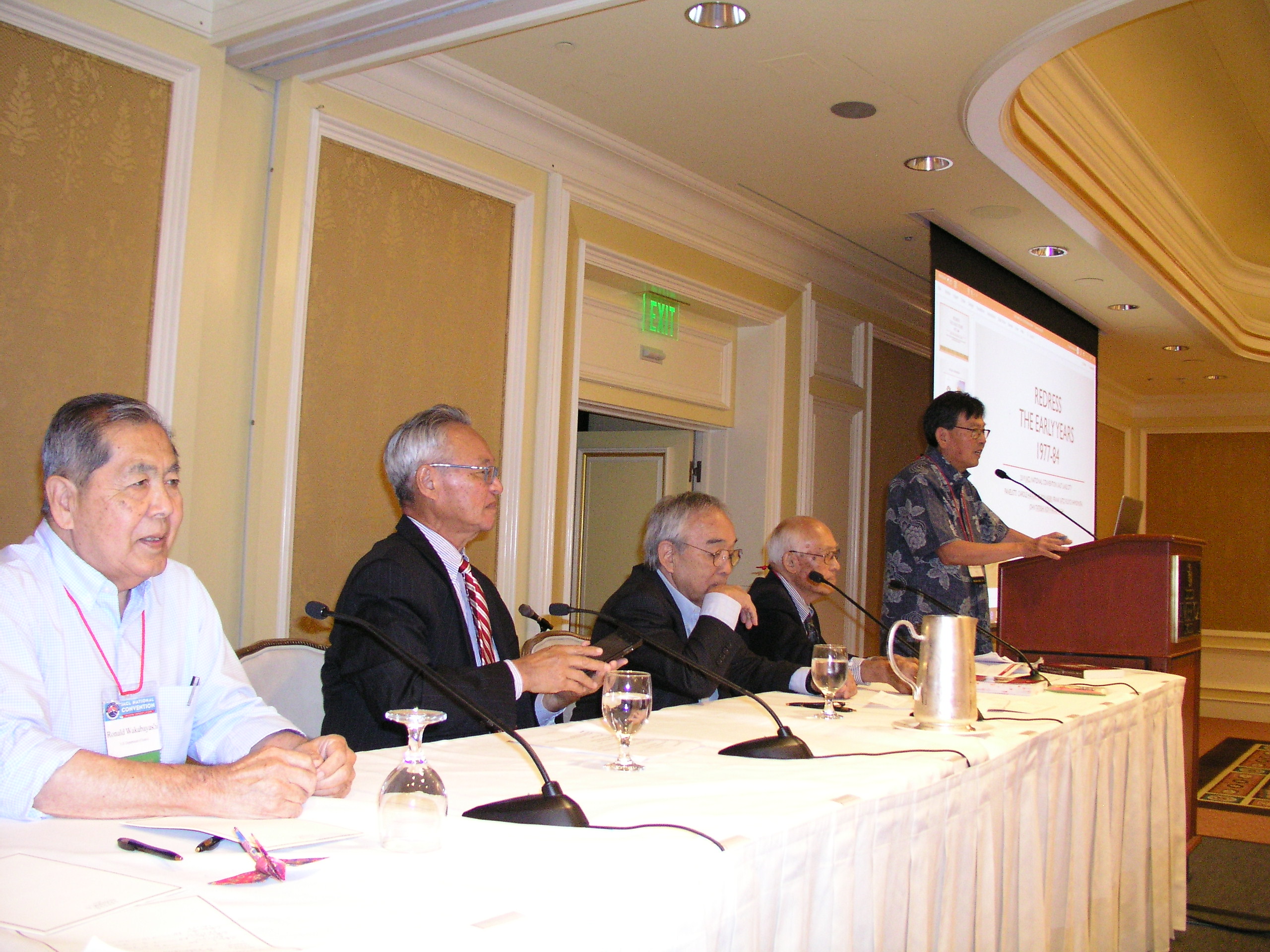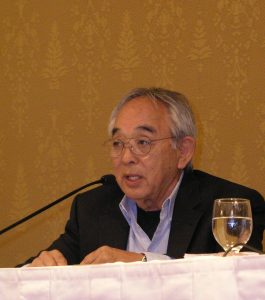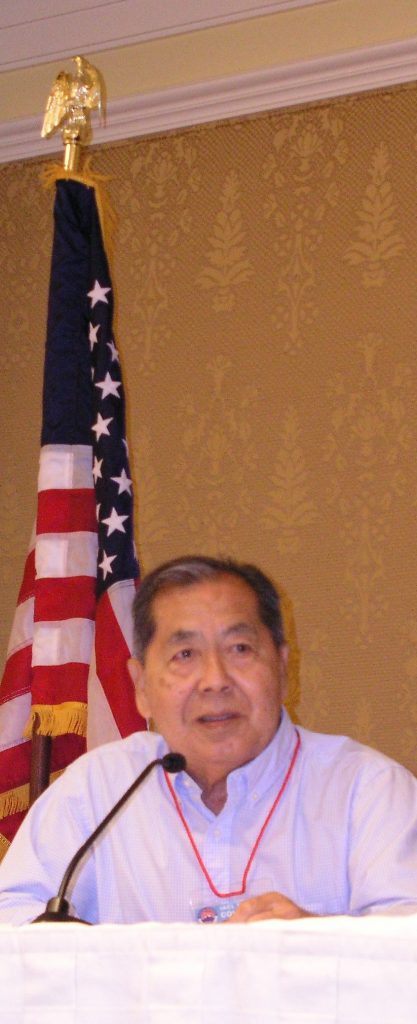
The Redress Plenary featured (from left) Ron Wakabayashi, Ronald Ikejiri, John Tateishi, Frank Sato and moderator Floyd Shimomura. (Photo: George Toshio Johnston)
JACL vets swap behind-the-scenes stories at 2019 JACL National Convention.
By P.C. Staff
Ever wonder why Japanese Americans who received monetary compensation for having had their constitutional rights abrogated during World War II received $20,000 instead of the initially proposed $25,000?
And how was Sen. S. I. Hayakawa (R-Calif.), who in his keynote speech at the 1978 JACL National Convention’s Sayonara Banquet expressed his “total opposition” to redress (Pacific Citizen, Aug. 11, 1978), persuaded only a few years later to join Sens. Daniel Inouye (D-Hawaii) and Spark Matsunaga (D-Hawaii) in backing a bill to form the Commission on Wartime Relocation and Internment of Civilians?
Or, did you know that the decision to create the CWRIC, which resulted in emotionally wrenching public testimony from former incarcerees and a report that concluded that what happened to ethnic Japanese in America was because of race prejudice, war hysteria and a failure of political leadership, was not initially embraced by many in the JACL or, for that matter, by the majority of Japanese Americans?
And that four years to the day before redress became a reality on Aug. 10, 1988, there was a meeting in the Reagan White House among JACL leaders that had to be kept secret for decades?
With the success of the Japanese American redress campaign now more than three decades in the past, those “hows,” “whys” and “didja knows” were discussed at the plenary titled “Early Redress Years: 1977-1984,” which took place at the 2019 National JACL Convention, held at the Little America Hotel in Salt Lake City.
The session featured Ronald Ikejiri, Frank Sato, Floyd Shimomura, John Tateishi and Ron Wakabayashi, all of whom were associated with JACL as leaders, participants and witnesses during a critical “seven-year period” in the 20-yearlong journey of redress from idea to reality. (Carole Hayashino, who was scheduled to be on the panel, had to bow out due to a family emergency.)
Toward its end, the session also featured additional perspectives from former congressman and cabinet member Norman Mineta, whose name came up again and again in the panelists’ recollections.
◊◊◊
[quote]Keep in mind, there was no model we could work with because it was the only time in the history of the country that any group had attempted to seek redress from the United States Congress.” — John Tateishi[/quote] Shimomura, who served as the panel’s moderator and former JACL national president from 1982-84, told the audience that the panel would focus on three topics: 1) the resolution that the JACL National Council approved in Salt Lake City at the 1978 JACL National Convention to pursue redress legislation; 2) how the CWRIC came into being; and 3) the “significant role that Frank Sato played in helping to lay the foundations” for the passage of the redress bill in August 1988 by President Ronald Reagan.In his opening remarks, Shimomura noted that while the JACL played an important role in the eventual passage of redress legislation, the campaign was “much bigger that just JACL,” referring to other organizations such as NCRR (then known as National Coalition for Redress and Reparations), National Council for Japanese American Redress (NCJAR) and the coram nobis team.
“They were all working on redress, but everybody’s focus had been a little different,” Shimomura said.
Shimomura also noted how it was fitting that the plenary was taking place in Salt Lake City — at the same hotel, no less — since the JACL National Convention of 1978 was “ … probably one of the most-historic conventions” because the JACL’s National Council approved the resolution to pursue redress legislation.
Shimomura also noted that panelist and former JACL National President Sato (1984-86), whose role in the run-up to redress would be discussed later in the session, had been born in 1929, meaning he was the same age as JACL itself.
◊◊◊
The discussion began with Tateishi, who was appointed as the chair of the JACL’s National Committee for Redress in 1978 and later served as JACL’s national director, national redress director and principal redress lobbyist until 1986.

John Tateishi was chair of the JACL’s National Committee for Redress in 1978. (Photo: George Toshio Johnston)
Tateishi referenced the 1978 JACL National Convention’s election of Clifford Uyeda, who ran as the “redress candidate” after serving for a year and a half as the chair of the National Redress Committee following the death of Edison Uno, who is regarded as one of the “founding fathers” of the campaign for redress.
Tateishi said that what pushed Uyeda over the top in voting was “ … a resolution that was introduced here at the convention. It was a resolution that defined what we would do as a policy of redress, and it said $25,000 per person affected by the government’s orders during WWII.”
Also included was a call for a trust fund, but left out were specifics on how any of this might happen. Also not included: a call for an apology, even though the Civil Liberties Act actual redress legislation of 1988 did include one.
“We decided not to include an apology because the feeling was that if we put that out there in front of politicians, that’s what they would choose, and they would ignore the money,” Tateishi said.
◊◊◊
Tateishi, noting that there were many young people in the audience, later gave some context to the attitudes toward redress at the time, especially by the Nisei.
“When we started the redress campaign, there was a lot of dissension,” he said, recalling that at the 1978 convention during the debate, there was “so much anger at us for doing this, for pushing it.”
Still, the JACL was more unified than the greater Japanese American community.
“There were pockets or groups of people who supported it, certainly the younger, post-WWII Sanseis were pushing it. But in general, the Nisei did not want this to happen,” Tateishi said.
They didn’t want to talk about the camps, which was exactly what would happen after the legislation to create the CWRIC was enacted by President Jimmy Carter in the summer of 1980 led to hearings in several U.S. cities where Nisei and Issei publicly — and cathartically — exposed their long-buried traumas, many for the first time.
The eventual decision to form a commission was one that came about after a meeting in early 1979 between the JACL’s National Redress Committee and members of Congress that Tateishi dubbed “the Big Four”: Sens. Inouye and Matsunaga, and Reps. Norman Mineta and Robert Matsui, both Democrats from California, all Japanese Americans.
While the National Redress Committee knew “that Norm Mineta was 100 percent behind this,” Tateishi said, what was unknown was where Inouye and Matsunaga stood on the issue. (During the session, it was noted that Matsui, who had just been elected to Congress in 1978, was still a newcomer to national politics.)
Tateishi related how they went into the meeting with the Big Four with a couple of different concepts. One was the “bootstrap plan,” an idea from the Seattle coalition, which was a check-off on the IRS 1040 form. The other idea was for legislation that asked for a direct-compensation bill.
“We would go to the hill and fight an honest fight, and if we died with it, we died — but at least it would be an honest fight,” he said.
It was here where the politically savvy Inouye weighed in, with Tateishi quoting him as saying, “What you’re trying to do is succeed.”
The implication: Neither of these plans would work. It was a dose of political reality for the JACL representatives.
“If we didn’t end up with monetary compensation in the pockets of everyone, that was failure,” Tateishi said. “So, we adjusted the definition [of success] as we moved the campaign.”
◊◊◊
Out of that meeting came the suggestion by Inouye to “seek the formation of a federal commission whose job it would be to investigate the circumstances that led to the internment,” Tateishi recalled.
Any conclusions and recommendations — be it for monetary compensation and, if so, the amount of any compensation, an apology or whatever — would be left up to the commission.
For the JACL reps, Tateishi said it was a course that “none of us wanted.” Ikejiri, who served from 1978-84 as JACL’s Washington Representative and was a former member of the Gardena City Council, said for many, a commission was “where you sent a good idea to die.”
Later, when the commission was formed, the reaction was less than favorable.
“Everyone in the community was kind of upset with this whole concept of a commission because anyone who was interned during WWII knows it was wrong, that it was constitutionally incorrect to have it happen,” Ikejiri said.
The wisdom of a commission to investigate the circumstances that led to mass violations of constitutional rights via mass evacuations and incarcerations was something that Shimomura clarified.
“Our constituents in JACL, they knew all about the internment, so why do you have to waste time figuring out if it was wrong or not?” he asked.
But that was not the case for people outside California.
“The problem wasn’t that a lot of people were against it (redress),” Shimomura said. “They didn’t even know what happened. I think the biggest problem was just getting the public educated on the issue.”
For the National Redress Committee, a big problem was what they wanted to do was unprecedented.
“Keep in mind, there was no model we could work with because it was the only time in the history of the country that any group had attempted to seek redress from the United States Congress. Everybody said it was doomed to failure,” Tateishi said.
◊◊◊
To create the commission, both the Senate and the House would need to pass their own bills, after which a version that was acceptable to both bodies would need to be sent to President Carter.
Ikejiri remembered the following exchange from the meeting with the Big Four.
“Inouye said, ‘Spark and I can get this past the Senate.’ And he looks at Norm. ‘What do you think, Norm?’
“John and I talked about it at lunch today. I don’t think Norm said anything,” Ikejiri recalled, eliciting laughs from the audience.
As it would happen, on the Senate side, S.1647 passed unanimously (Pacific Citizen, May 30, 1980) — and thanks to Mineta’s efforts, the House version of the bill to form a commission passed overwhelmingly, 279-109.
According to Ikejiri, Inouye sent a congratulatory note to Mineta that contained one word: “Formidable.”
◊◊◊
Getting to that unanimous vote on the Senate side, however, meant precluding any possibility that California’s Sen. Hayakawa, who had already stated his opposition to redress, would derail the bill to form a commission.
According to Ikejiri, Matsunaga said that the Big Four should go to Hayakawa’s office because it was vital for the bill’s passage that there be no dissension among the three Nikkei senators.
It was a necessary break in protocol that dictated that such a meeting to ask Hayakawa to support the commission bill take place in his office. Typically, such a meeting should take place in the office of the most senior member of Congress, meaning Inouye.
More important, however, was preventing “three Japanese Americans on the floor of the Senate arguing this matter,” Ikejiri said. If that happened, the bill would go nowhere.
“A date was set, and we were going to go to Sen. Hayakawa’s office. And for some reason, I knew Congressman Mineta, Congressman Matsui were going to be busy that day,” Ikejiri said, again elicting laughs from the audience. “And so, the meeting was starting at 1 o’clock in Sen. Hayakawa’s office. Sparky shows up, his staff shows up. Inouye and his staff show up. I show up, and then we’re waiting for Bob and Norm to come. I knew they weren’t going to come.
“Sen. Inouye’s staff person, on cue, left the room,” Ikejiri continued. “This is before they had cellphones. She came back about five minutes later and says, ‘I’m sorry, there’s a vote on the House floor and Congressmen Mineta and Matsui have to vote and won’t make this meeting.
“As soon as Sen. Inouye started speaking, Sen. Hayakawa’s staff person, who happened to be from the Hoover Institute at Stanford, butted in and cut off Sen. Inouye, which was a mistake.
“I don’t know if you’ve ever seen Sen. Inouye get mad. He doesn’t get angry. He just looks at you. And he looked at this staff person, and he knew he had to keep quiet.
“Despite the uproar by his own staff, Sen. Hayakawa agreed to go on. … I always thought that was a very interesting meeting,” he concluded.
◊◊◊
From Shimomura’s perspective, after the commission bill passed, he began to notice a change in the Japanese American community’s attitude toward a commission.
“Even those that were skeptical, I think they started to feel like, ‘Maybe this wasn’t our first choice, but now it’s going to go into existence, so we’re going to do everything we can to make the commission successful, to make the best case for redress. At that point, I started to see the community start to pull together,” he said.
With the commission a reality and hearings in several cities imminent, the challenge was going to be to get Nisei — a verbally reticent part of the already verbally reticent “Greatest Generation” — to talk.

Ron Wakabayashi was the JACL National Director for 10 years. (Photo: George Toshio Johnston)
Wakabayashi, who has been the western regional director for the Community Relations Service of the Department of Justice for the last 20 years and before that the JACL national director for 10 years, despite being a self-described “outlier” in the organization’s structure who said he was only one of two JACLers to resign twice (and get rehired), credited the absent Hayashino for a scheme that ultimately proved effective — but showed how difficult it would be to get people to talk about their experiences.
The idea was to hold mock hearings in Northern California to prepare the Nisei to talk about what happened to them. They convened a group of JACL chapter presidents to give five minutes of testimony.
“We got Quentin Kopp, kind of a curmudgeonly member of the San Francisco Board of Supervisors, and a couple of judges to play commissioners, just to kind of do a walkthrough because there was not enough experience with commissions.
“So, we go and do this and the first chapter president goes up, and then he can’t continue. He breaks down. Second guy. He breaks down. Third guy breaks down. Fourth guy. We didn’t get one completed that day,” Wakabayashi said. “No one finished.”
Relating the conversation he had with his wife, who was a psychiatric social worker, about what he witnessed that day, Wakabayashi expressed his worry.
“Jean, I’ve not seen Niseis cry, I don’t see them break down. It’s not like they were sobbing, but no one could finish,” Wakabayashi recalled. “And that scares me.”
(Editor’s Note: To read Part II of this story, click here.)



